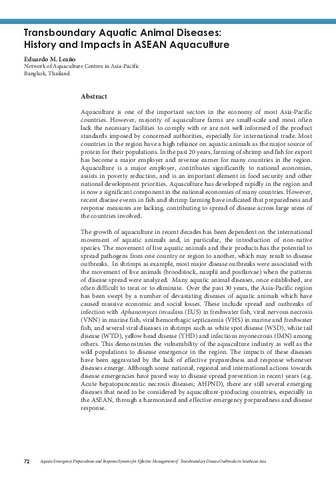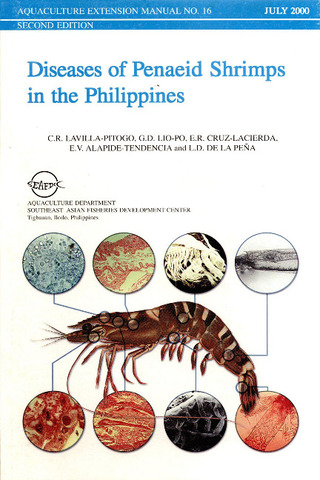Disease management in shrimp farming
| dc.contributor.author | Lavilla-Pitogo, Celia R. | |
| dc.contributor.editor | Subasinghe, S. | |
| dc.contributor.editor | Singh, T. | |
| dc.date.accessioned | 2011-06-22T09:36:00Z | |
| dc.date.available | 2011-06-22T09:36:00Z | |
| dc.date.issued | 2002 | |
| dc.identifier.uri | http://hdl.handle.net/10862/477 | |
| dc.description.abstract | Shrimp monoculture systems have been beset with devastating losses due to infectious diseases and environmental deterioration. On a global scale, efforts to make shrimp culture a sustainable industry are warranted because of the high value and demand of shrimp. A Code of Practice for Sustainable Shrimp Farming prepared by the Global Aquaculture Alliance has been adopted by various shrimp producing countries addressing issues like mangroves, site evaluation, design and construction, feeds and feed use, shrimp health management, therapeutic agents and other chemicals, general pond operations, effluents and solid wastes, and community and employee relations. Shrimp hatcheries have benefited from technological advances in practically every aspect of rearing including implements to control water quality, eliminate pathogens, and improved nutrition through innovative artificial feeds and supplements. These technologies have made postlarval production very successful, although in many cases, high survival cannot exactly be equated with good quality. Thus a closer look at hatcheries is essential to ensure that rearing protocols match the conditions to which postlarvae will be exposed to upon stocking in ponds. Compiled information on the estimated number of hatcheries and forms in major shrimp growing areas in Asia show a relatively smaller number of small independent hatcheries compared to farms, which demonstrates that effective disease control programmes need to emanate from hatcheries. Presently, three programmes for the hatchery need serious attention. These are (a) the continued implementation of fry analysis procedures, not only as a marketing tool, but so as to exclude pathogenic organisms from ponds, (b) adherence to agreed-upon codes of practice and conformity with accepted guidelines on live transfers to minimise disease spread, and (c) development of a reliable source of domesticated broodstock and incorporating specific pathogen free (SPF) and specific pathogen resistant (SPR) stocks in these programmes to minimise or eliminate dependence on wild broodstock. One of the main constraints is the lack of cost-effective and efficient methods to prevent and correct environmental deterioration, and to maintain biosecurity. In addition to providing primary health care, disease control strategies should be a combination of pathogen exclusion and environmental management: the former for primary pathogens such as viruses and the latter for secondary pathogens like bacteria, whose pathogenicity is heightened by environmental degradation and lowered resistance of shrimps. Shrimp forming should start employing systems to manage and lessen waste and the outflow of organic pollutants that could contribute to self-pollution or deterioration of the quality of receiving waters. These include improved feeds and conversion ratios to make feed utilisation more economical and efficient, implementation of recirculating or zero discharge technology, improving the efficiency of aeration systems, improvement of pond siting, understanding of the pond ecosystem and the role of microbes in the environment. In addition to implementing disease control measures and ensuring product quality in various industry sectors, approaches need to be welded together for a holistic approach to health management. | en |
| dc.language.iso | en | en |
| dc.publisher | INFOFISH | en |
| dc.relation.ispartof | In: Subasinghe, S., Singh, T. (eds.). Production and Marketing of Shrimp: Trends & Outlook. Proceedings of Shrimp 2001 Chennai, The Fourth World Conference on the Shrimp Industry and Trade and Buyer-Seller Meet, 27-29 September 2001, Chennai, India. Kuala Lumpur, Malaysia: INFOFISH. pp. 147-154 | en |
| dc.subject | Crustacea | en |
| dc.subject | animal health | en |
| dc.subject | Philippines | en |
| dc.subject | prawns and shrimps | en |
| dc.subject.lcc | VF SP 282 | |
| dc.title | Disease management in shrimp farming | en |
| dc.type | Conference paper | en |
| dc.citation.spage | 147 | |
| dc.citation.epage | 154 | |
| dc.citation.conferenceTitle | Production and Marketing of Shrimp: Trends & Outlook. Proceedings of Shrimp 2001 Chennai, The Fourth World Conference on the Shrimp Industry and Trade and Buyer-Seller Meet, 27-29 September 2001, Chennai, India | en |
| dc.subject.asfa | shrimp culture | en |
| dc.subject.asfa | diseases | en |
| dc.subject.asfa | disease transmission | en |
| dc.subject.asfa | disease prophylaxis | en |
| dc.subject.asfa | viral diseases | en |
Files in this item
| Files | Size | Format | View |
|---|---|---|---|
|
There are no files associated with this item. |
|||
This item appears in the following Collection(s)
-
Conference Proceedings [298]




